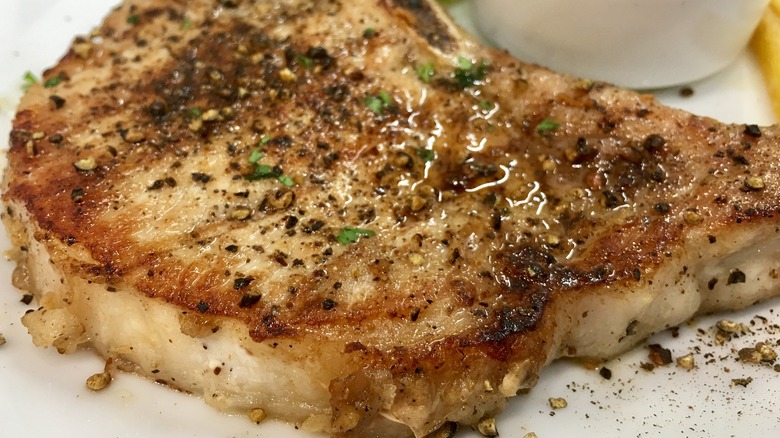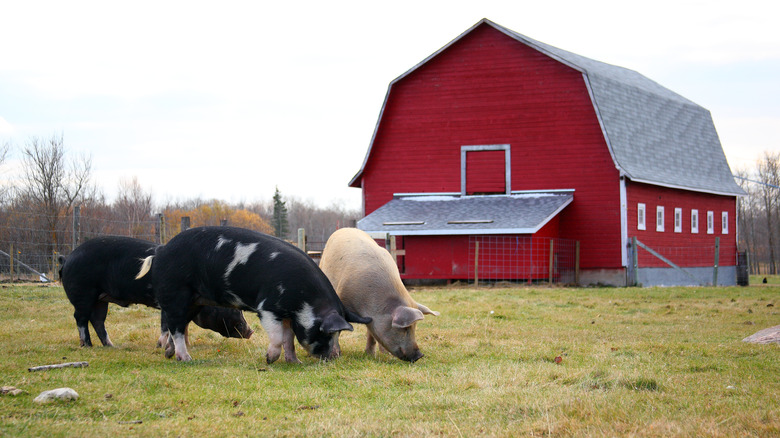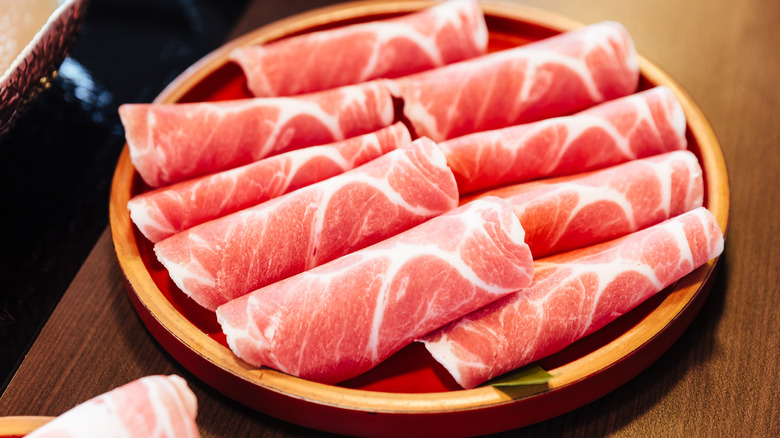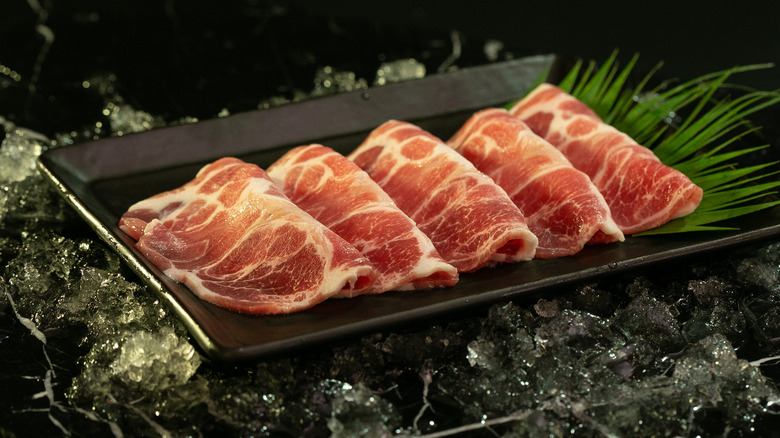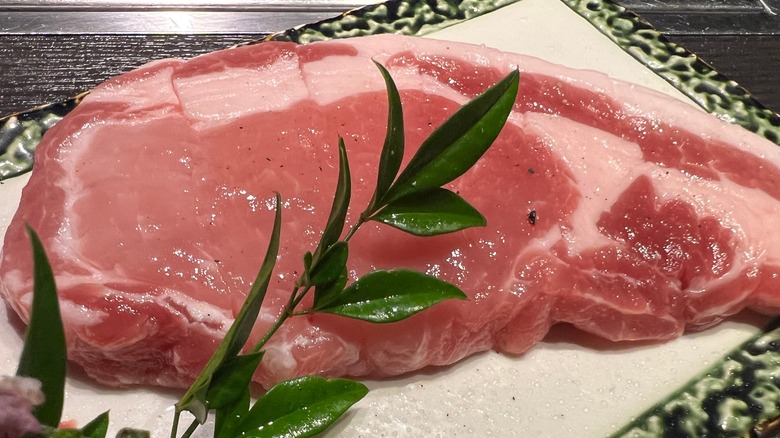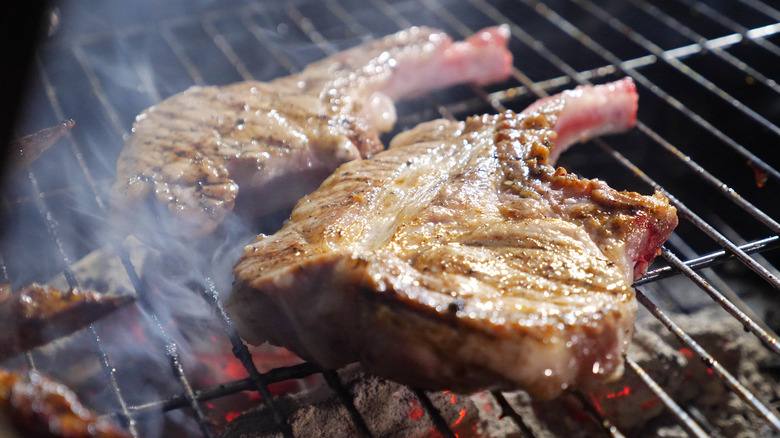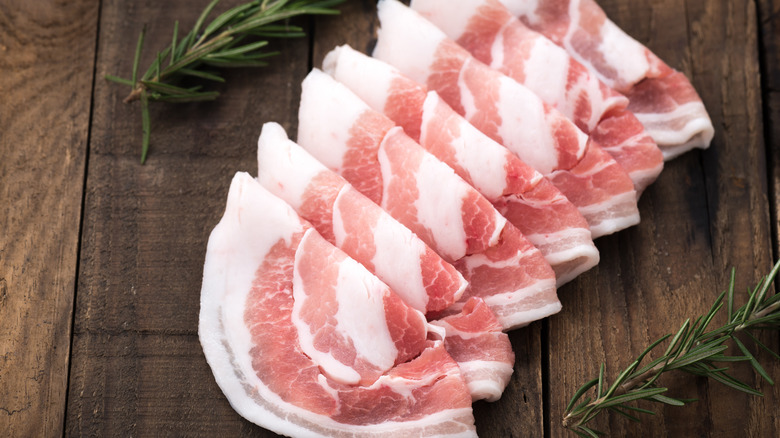What Is Kurobuta Pork?
With grocery stores posting some of the highest prices in decades, it may sting to pay more than an average amount of money for pork. But Kurobuta isn't your average pork, and it doesn't come from an ordinary animal. It's considered a specialty pork product and comes from a heritage breed of pigs, which the Livestock Conservancy defines as registered purebred swine or the offspring of such. The breed is interchangeably called Kurobuta and Berkshire, based on location and language. But it's the same pig, which shares a common history.
The Berkshire breed is at least 300 years old, native to Berkshire County in England where the pigs were once reportedly kept by the royal family in the pasture lands of Windsor Castle. In the mid-19th century, some of the exclusive animals were gifted to the Emperor of Japan, where they now bear the name Kurobuta, the Japanese word for "black pigs." It's easy to identify these hefty animals by their deep black coats, white legs, and sporadic white body spots.
But color is by no means the only thing differentiating Kurobutas from other swine species. It's the flavor, tenderness, and juicy composition that makes them special — all cultivated and influenced by genetics as well as breeding, feeding, and care practices.
Kurobuta is the Wagyu of pork
Exclusive types of beef such as Wagyu and Kobe get more attention in the United States, but the same standards apply to Kurobuta, or Berkshire, pork. It doesn't mean the meat comes from Japan or England; A growing number of heritage swine producers in America carry on the purebred line that first arrived in 1823, touted as superior animals bearing high-quality meat.
Defining characteristics of Kurobuta pork include a high amount of marbling that produces fat with lower melting points, resulting in a succulent buttery taste with tinges of sweetness. The marbling also helps the meat cook faster and more evenly at higher heat. A natural smooth texture and tenderness in the pork come from short muscle fibers, while a relatively high pH balance facilitates a firmness that helps retain fluids, resulting in juicy flavors.
These things are no accident, since most heritage pork producers, especially those raising Kurobuta pigs, adhere to practices uncommon in the overall industry. Those same practices partially explain the high prices that consumers pay for noticeably higher quality.
Production practices influence price and quality
Many Kurobuta pig breeders are small or medium-sized family farmers dedicated to more time-consuming and/or costly practices. These can include natural growth unaided by hormone or steroid injections, as well as healthy diets incorporating vitamins and rolled oats, corn, soybean meal, and other clean animal-feed mixtures.
Many growers provide stress-free environments with hands-on care and free-range habitats rather than gestation stalls, which makes for healthier pigs and healthier pork on dinner tables. But all these factors can require more labor, more growing time, and higher feed costs, resulting in smaller herds and less profit. These costs inevitably pass to end-consumers willing to pay for healthier high-quality pork that's likely free from additives and antibiotic residues.
What does Kurobuta pork taste like?
If you are willing to pay the price that Kurobuta pork demands, you will certainly be hoping for something special in terms of flavor. Its nickname 'the wagyu of pork' should give you a clue as to the quality of the meat in question — this pork is certainly a cut above the rest. As any meat lover knows, the key to a tasty piece of pork is in the fat, and Kurobuta pork has plenty. The fat is marbled perfectly throughout the meat, giving it a juicy texture with incredible flavor.
The exceptional flavor comes from the breed of pig itself as well as the way they are treated. Berkshire pigs naturally have more marbling in their muscle than other breeds, meaning that good flavor is more likely even when raised conventionally. However, the pigs farmed for Kurobuta pork are fed a special high-quality diet and raised in as stress-free an environment as possible, both factors that are shown to improve the quality and flavor of the meat. Kurobuta pigs are raised as free range, with access to foods such as nuts, oats, and like the famous wagyu cattle, occasionally beer as well.
Of course, pampering pigs in this way ain't cheap, leading to the premium price associated with this prized meat. But if you are a fan of super-tasty pork, it is definitely worth shelling out occasionally for this wonderfully meat-tasting experience.
Where to buy or order Kurobuta pork
If you're looking to get your hands on some prized Kurobuta pork in the United States, you are in luck. Though popular in Japan throughout most of the last century, it didn't start to gain favor in the U.S. until the 1980s. There are now farms across the country who specialize in raising these extraordinary pigs, meaning that accessing some beautiful meat is easier than ever.
In your quest for Kurobuta, start at a high-quality butcher or farmer's market. Even if you can't find what you're looking for, they may be able to point you in the right direction or order some especially for you. If you aren't able to find it in person, there are many online retailers who specialize in Kurobuta pork, including Snake River Farms, who ship a variety of cuts, including bacon and spare ribs, to all 50 states. The wealth of online specialty shops means that sourcing high-quality meat like Kurobuta pork is easier than you may think, so there is nothing stopping you treating your taste buds to this gastronomic delight.
How to cook with Kurobuta pork
For the price a piece of Kurobuta pork will set you back, you want to make sure you cook it well and do it justice. Cooking as high-quality meat as this is all about keeping things simple and letting the pork speak for itself. The worst thing you could do with this precious meat is overcook it. If in doubt, remember you can always cook it longer if it's underdone, but once it has gone over, it will be ruined.
For precision results, a meat thermometer allows you to monitor the cooking of the pork accurately. According to the USDA, pork dishes should be brought to an internal temperature of 145 degrees Fahrenheit to ensure it is fully cooked. The high fat content of Kurobuta compared to conventional pork means it will cook more quickly, so be sure to amend your usual recipe to accommodate this. Depending on the cut, cooking on the stovetop will get you the best results, coupled with roasting in the oven. Alternatively, a large piece of Kurobuta pork such as shoulder may benefit from slow-cooking, allowing the connective tissue to break down and become tender and delicious.
Once you have worked out how long to cook your particular cut of Kurobuta pork, make a simple seasoning to rub on the surface before cooking. A flavored salt will enhance the taste of the pork without overpowering, and allow the delicious natural flavors of the meat to shine through.
Nutritional info for Kurobuta pork
We know that flavor-wise, Kurobuta pork is unequaled, but how does it stack up in the nutrition stakes? Well, pork in general is a good option for meat eaters, and Kurobuta pork has a few added benefits of its own.
Pork is a good source of high-quality protein, which is great for your muscles, skin, and bones. It is extremely important for allowing your body to heal, and is needed for a strong immune system. Pork is also rich in a number of crucial vitamins and minerals, including various B vitamins, zinc, and iron.
Some people may be concerned about the higher fat content of Kurobuta pork, which is, of course, what creates its delicious flavor. The good news is that the meat from Berkshire pigs is rich in omega-3 fats and monounsaturated fatty acids, both known to be important for heart health, according to the Korean Journal for Food Science of Animal Resources. So while Kurobuta pork may seem like an indulgent treat, there are healthy reasons to enjoy this meat regularly.
How to store Kurobuta pork
Once you have gone to the effort and expense of buying Kurobuta pork and cooking it to perfection, you of course want to savor every delicious bite. In the unlikely event that you aren't able to finish your plate, you want to make sure you store it correctly so that you can get the full enjoyment out of this prized meat by eating it at another time. Similarly, you may decide to buy more than one meal's worth — especially if you are paying to have it delivered — so understanding the optimal storage environment is crucial.
If you have bought your Kurobuta pork fresh, it can be kept in the refrigerator for three to five days. Ideally, make space on the bottom shelf of your fridge to accommodate the meat, as that shelf is the coldest. If you know you won't be eating your pork within the recommended time frame, freeze it as soon as you get it home. It can be frozen for up to 12 months without the flavor and texture being affected. Defrost overnight in the fridge when needed and be sure to cook thoroughly.
If you are storing leftovers, the USDA recommends they can be safely kept in the fridge for three to four days. Be sure to use them up within this time, as you don't want to throw out this wonderful meat.

